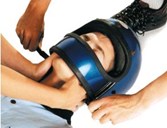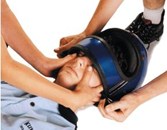Electricity
Domestic electricity
Although the domestic electricity supply is low voltage, accidental contact with a live conductor can cause serious injury or death. A characteristic injury is seen as an entry burn at the point of contact, plus a more extensive exit burn where the electricity went to ‘earth’.
The first aider must remember to make the area safe before attempting to touch or rescue the patient. The source of electricity must be identified and contact broken in the easiest but safest manner. If it is possible to remove an appliance plug from the power supply point, then this will stop the flow of electricity. DO NOT rely on the power point switch because it is still possible for electricity to flow even after the switch has been turned off. Alternatively, the power should be turned off at the mains supply board to ensure safety for all concerned.
If the patient does not need CPR, the first aider should check for any burns, looking carefully for the exit burn that is likely to be the most serious injury. First aid treatment is needed to protect any wound and reduce further damage. Treat as for any burn.
High-voltage electricity
The electricity supply that is seen in the street and which runs between high power poles is generally high voltage. Similar high-voltage power may be found at major factories and workshops. If a high-voltage power cable is brought down in an accident, it is very dangerous for anyone in the area. High-voltage electricity can travel up to 8 metres from the cable, and possibly further in damp or wet conditions. Therefore all bystanders must remain more than 8 metres from the power cable and no first aid or emergency care can be given until the electricity supply authority has declared the area safe. Any other action is likely to result in death.
An accident patient cannot be rescued from an area that has been energised by high-voltage power, but the first aider should shout advice and warn the patient against any attempt to move or leave the area. If the patient has survived the initial accident, their survival may depend on staying in one place until a safe rescue can be carried out after the power has been disconnected.
If a driver is trapped in a car with a high-voltage cable in contact with the vehicle, the patient is safe as long as there is no attempt to leave the car. Again, advice can be shouted to the conscious patient and reassurance given that the emergency services have been called and are due to arrive at any moment. For example, if the conscious patient has a bleeding wound, shouted advice can be given to apply pressure with elevation and rest.
Road crashes
Whether a driver, passenger or pedestrian, the patient who has been involved in a road accident can be seriously injured and in need of urgent medical assessment and treatment. The first aider might be the first person on the scene and may be influential in saving a life before the arrival of ambulance personnel. Anyone involved in the accident might also need support although there may be no obvious injuries. The driver of a car that has hit a pedestrian or cyclist will be most distressed and will require reassurance.
Motor vehicle crash patients
Whatever the circumstances, the first aider must ensure safety for self, patient and bystanders. This may involve obtaining help to make the area safe.
There are serious risks in trying to assess and treat an accident patient on a roadway or where there is traffic. If the patient is lying on the road or in a position of danger from passing traffic, ensure oncoming traffic is warned. If injuries are minor, move the patient off the road. If you have not stopped at the scene, and others have stopped, DO NOT call for an ambulance as you need to provide information about the crash.
When a person appears to have extensive injuries and is still seated in a vehicle, it is best to avoid movement of any nature unless it is essential for the patient’s wellbeing. For example, when a person becomes unconscious it is advisable to reposition or remove the patient from the vehicle to ensure adequate protection of the airway. Remember that if you must move the patient, move them carefully (using others to help, if possible), and try to keep the spine in a straight line as the patient may have significant underlying injuries.
Motorcycle crash patients
A person who is involved in a motorcycle crash may receive multiple injuries and could have a spinal injury.
The first step is to ensure safety for the first aider, patient, and any bystanders.
If the patient is unconscious it may be necessary to remove the rider’s helmet to gain access to the airway. Initially, if there is no response, the patient should be carefully rolled onto their side for airway care. If a detachable visor is present, it should be carefully removed to permit access to the mouth and nose area. If a chin strap is present, it should be undone or cut through to allow access to the mouth and lower jaw.
The helmet may still provide protection to the patient’s head and the first aider may not need to remove it. If the patient is conscious and breathing with a clear airway, it is best to leave the helmet in place until the arrival of the ambulance.
If the patient is not breathing normally it is essential to remove the helmet to allow the airway to be opened and cleared.
Removal of the helmet
To remove the helmet it is best to have two people available: one to steady the head and neck and the other to gently remove the helmet.
One person must support the patient’s neck and head. Face the patient and place one hand around each side of the upper neck and splay out fingers around the base of the head ready for when the other person removes the helmet.
However, if there are no bystanders present the first aider must carry out the manoeuvre without help as follows:
• The sides of the helmet must be pulled outwards to loosen the moulded grip over the ears.
• The helmet is tilted forwards to lift it over the back of the head.
 Removal of the helmet
Removal of the helmet
 Removal of the helmet
Removal of the helmet
Fire or toxic fumes
When fire complicates an emergency, the first aider should be conscious of the danger and the serious risks of going into a burning room or building. Home fires are associated with the release of toxic fumes from furniture made of synthetic products. Entry into a place where there is dense smoke or toxic fumes is not recommended and may result in the loss of another life. Fire officers will generally use breathing apparatus to give protection from smoke or fumes and the first aider should make sure that the emergency services have been called and wait for such trained assistance to arrive.
If caught in a smoke-filled area, the first aider should drop to the floor and attempt to crawl to safety. If a patient has collapsed in the area, drag them to a place of safety.
If smoke or toxic fumes overcome the patient, make a rapid assessment of them and be prepared to carry out CPR if necessary. If the patient has inhaled any smoke or toxic fumes, the mouth, throat and lower airways may have been burned. Look for signs of burning – e.g. singed hairs inside the nose or hoarseness, coughing, or noisy breathing.
All patients exposed to inhaled toxic fumes require a medical assessment.
Sometimes a patient may be found with clothing on fire. The immediate response is to get the patient to floor level and wrapped in a cotton or wool blanket to extinguish the flames. The best advice to follow is to STOP, DROP and ROLL to extinguish the flames and avoid any further injury.
Have the information on hand when you need it the most.
Buy the First Aid Handbook >>
Learn the practical skills to help save a life.
Book a first aid course >>